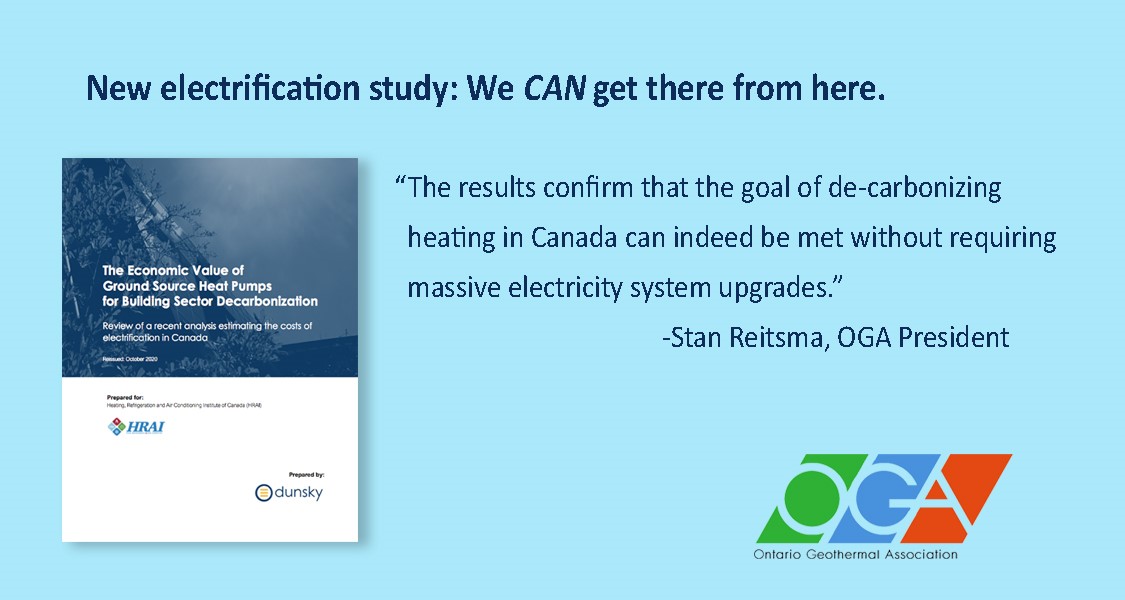WE CAN GET THERE FROM HERE
Sept 30, 2020
To OGA members and friends of the OGA:
We can get there from here. A new study conducted by Dunsky Energy Consulting highlights the unique advantages of ground-source heat pumps, not just to individual building occupants, but to the electricity system, as Canada prepares to electrify buildings and reduce carbon emissions. As in other jurisdictions, Canada’s electricity grid and power supply capacity must be capable of meeting peak demand.
Plans to replace our current reliance on carbon-based fuels with electric modes of heating have created legitimate worries about how to ensure capacity to meet demand spikes.

The study concludes that if the heating of homes and buildings across Canada were electrified using ground source heat pumps rather than air source heat pumps (which have been assumed as the default in most electrification scenarios) there would be billions of dollars in net savings for Canada’s electric system, as opposed to net costs. That’s because very high ground source heat pump efficiencies, unaffected by outdoor temperatures, will help mitigate the peak electricity generation requirements of the grid.
“Switching just 10% of homes to ground source instead of air source heat pumps would save between $26 billion and $49 billion,” said Stan Reitsma, President of the OGA, “which equates to a net saving to Canada’s electric system of more than $40,000 for every household choosing this option, and that’s after allowing for the cost of installing these systems.” Given the improved understanding we now have about this return on investment, it is not unreasonable to contemplate a higher adoption rate. The study estimates that at a 30% market adoption rate, Canadians would enjoy net savings of $148 billion.
Said Martin Luymes, VP of Government and Stakeholder Relations at HRAI. “While the latest air source heat pumps perform at impressive efficiencies, a unique benefit of ground systems is their ability to perform consistently at high efficiencies regardless of outdoor air temperatures, due to their reliance on more stable thermal energy stored in the ground. Deployed at scale they will effectively ‘flatten the curve,’ reducing peak electricity demand for the whole grid.”
The Dunsky study quantifies the system-wide benefits of this technology, demonstrating that the avoided electricity system development costs will more than pay for the investment in these heating systems. “The results confirm that the goal of de-carbonizing heating in Canada can indeed be met without requiring massive electricity system upgrades,” said Reitsma, “if we start investing now in smart technologies like ground source heat pumps.”
The analysis was commissioned by the Ontario Geothermal Association (OGA) in partnership with the Heating, Refrigeration and Air-conditioning Institute of Canada (HRAI), partly as a review of another analysis undertaken by the ICF on behalf of the Canadian Gas Association (CGA), which excluded ground source heat pumps and consideration of their unique ability to reduce peak load impacts on the grid. But the Dunsky analysis found questionable assumptions and some data difficulties in the ICF document. More likely assumptions and technology efficiencies led to the conclusion that Canadians will benefit greatly from electrification involving ground source heat pumps.
Members and any other interested parties can download the study from this site and can lift the social media elements and republish them on your own web and social media sites. The HRAI is working to ensure the right people in government departments are aware of the study’s findings.













